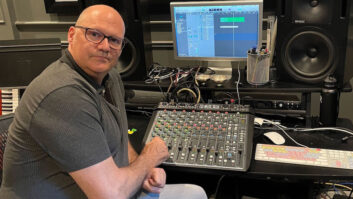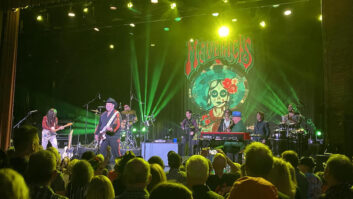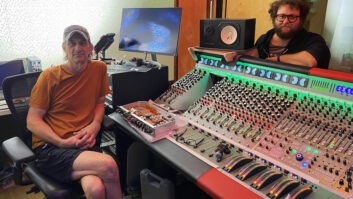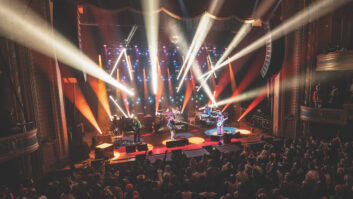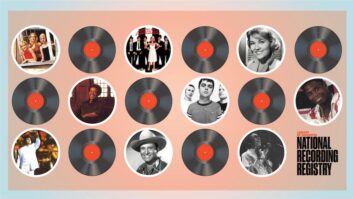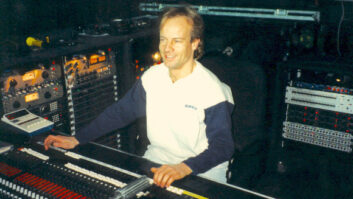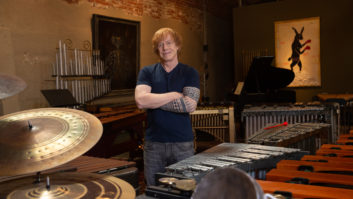Twenty attendees from as far afield as Hong Kong, Brazil and Europe attended The Art of Recording a Big Band, the latest in the Studio Prodigy Master Class Series, where they learned from Al Schmitt (center) and Steve Genewick, at Hollywood’s Capitol Studios. HOLLYWOOD, CA—Grammy-winning engineer and producer Ryan Hewitt presented the third in his Studio Prodigy Master Class Series, Al Schmitt and Steve Genewick: The Art of Recording a Big Band, at Hollywood’s Capitol Studios in late August.

“Pay attention,” admonished Capitol staff engineer Steve Genewick, who has worked with 22-time Grammy- winner Schmitt for more than 12 years. “I like to tell people who come to watch Al work that there’s not going to be a bright light that comes on and says, ‘Now he’s making a record.’ You have to pay attention, because what might have just happened was it! It might be a fader move; it might be the talkback.”
The weekend session, featuring a day of recording and a day of mixing with composer and arranger Chris Walden and his 17-piece band, attracted about 20 attendees from as far afield as Hong Kong, Brazil and Europe. Studio Prodigy’s sponsors include Audio-Technica, Delta H Design, Mojave Audio, Royer Labs, Tube-Tech and Vintage King Audio, which contributed various product giveaways and technology demonstrations. According to Shevy Shovlin, Vintage King’s director of partner marketing and PR, in attendance with a video team, edited highlights from the session will be available online in a few months.
Schmitt typically begins mixing the moment the musicians arrive. “I just start when the bass player gets here; I set mics and have him play a little bit,” explained Schmitt. “Then maybe the drummer, and get a general level set. I’ll listen to the room [mics] and then turn them off and get the basic balance with the close mics.”
Schmitt constantly listens to the input levels to the Pro Tools|HD system—set at 24/96; the tracks are mixed to a 192 kHz file—via the long faders on Studio A’s Neve 88R console, with the short faders assigned to playback. He monitors everything on a pair of VU meters in a box atop the meterbridge.
“As it goes down, we’re constantly mixing; I ride gains. Tomorrow, we just hit the button, drop everything down, and mix [on the long faders],” said Schmitt.
Attendees, including Grammy-winning engineer, producer and mixer Andrew Scheps (foreground) were given plenty of opportunities to solo tracks and dissect Schmitt’s mix. Tracking sessions involved a variety of preamps, including Neve 1081, 1081R and 31081 models, as well as Studer 1019s (for their analog path), Great River and custom Upstate Audio units. Room mics were RCA ribbons with vintage Neumann plus newer Royer Labs models on the brass and woodwinds.

Other than Summit Audio TLA- 100A compressors for the vocals— provided by Walden regulars Tierney Sutton and Courtney Fortune—and the acoustic bass, Schmitt used very little processing when tracking. “We probably won’t use an EQ on this whole record,” Genewick predicted.
On the second day, the outboard equipment was swapped out for Schmitt’s usual mix racks. “There’s nothing sacred about any of the settings,” said Genewick, encouraging attendees to study the gear and to watch over his and Schmitt’s shoulders. “We’ll let you guys sit at the console and solo stuff. That’s why you’re here.”
The reverbs, all on stock programs, were initially set the same way for every mix and always assigned to the same eight sends: two Lexicon 480s, a Bricasti M7, Capitol’s chamber #4, a Lexicon PCM96 and three TC Electronic 6000s. “A lot of the reverbs we use are very short. A lot of them are on the darker side. If you hear something with a tail, it’s probably the chamber,” said Genewick. “Al doesn’t try to put more than one thing into a reverb, but he might put one thing into more than one reverb.”
The acoustic bass received 2 dB of compression through a pair of Summits and the piano passed through a Phoenix compressor. The vocal was sent to a Fairchild 660 tube compressor: “Our favorite EQ,” commented Genewick.
“The stereo bus goes through a Tube-Tech [SMC2B] compressor and then an NTI EQ3. He basically uses the Air Band on the NTI. He’ll get a basic balance with [the Tube- Tech] out. Once he gets all the tracks up, then he will put it in. Most of his rides are done relative to that. Towards the end of the mix, he may adjust the amount of compression,” said Genewick.
“He uses this stuff because he likes the sound of the tubes.”
